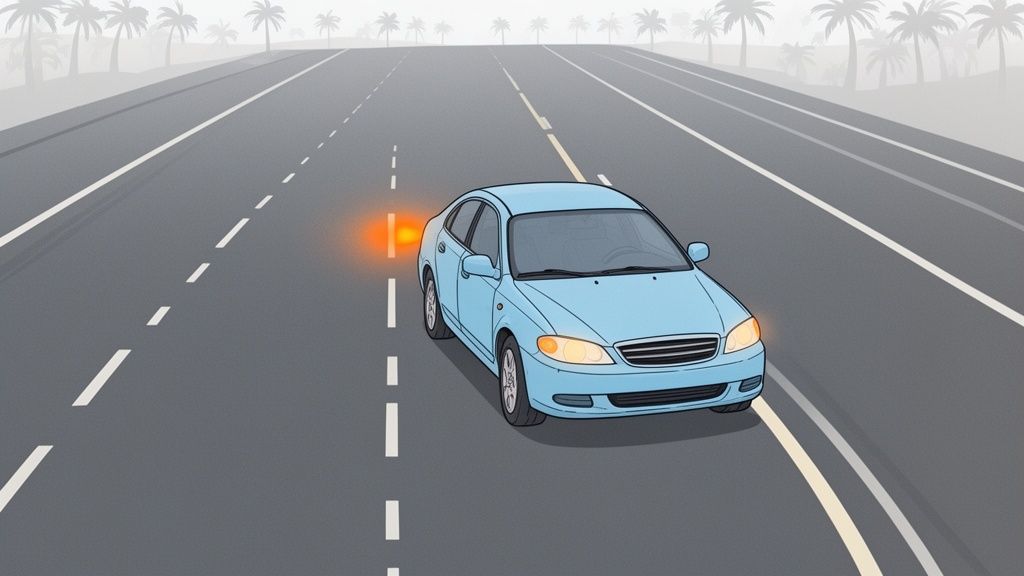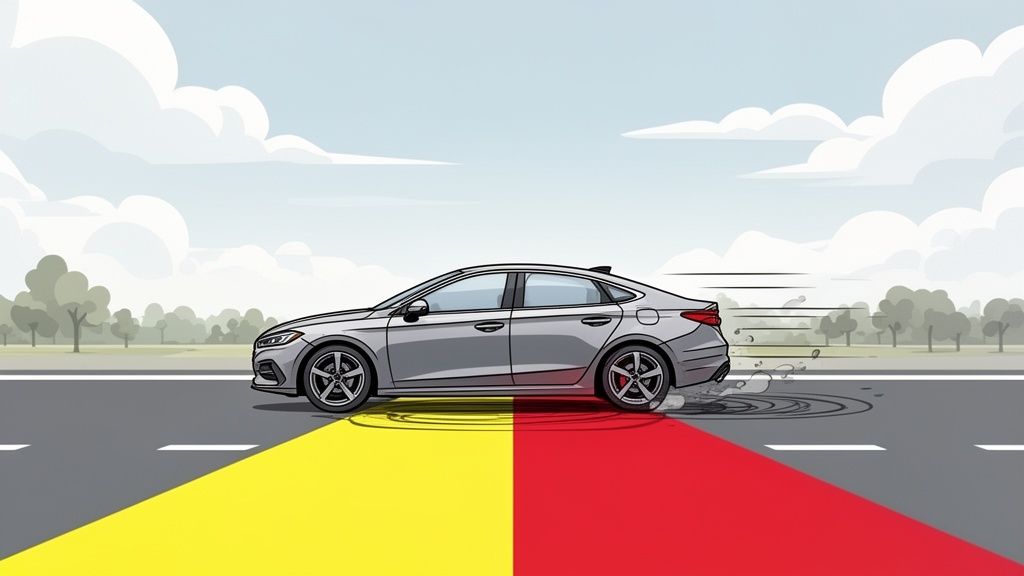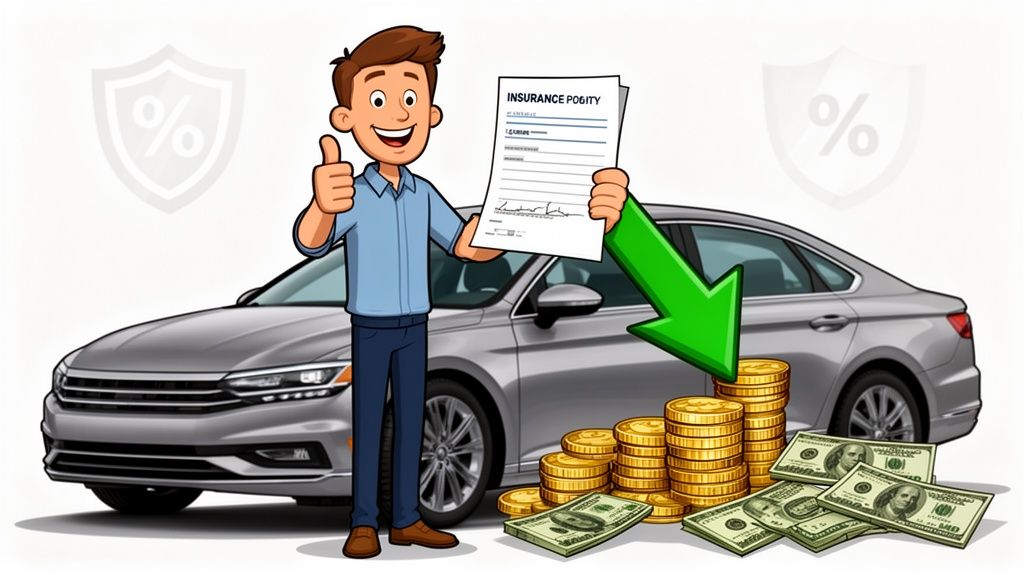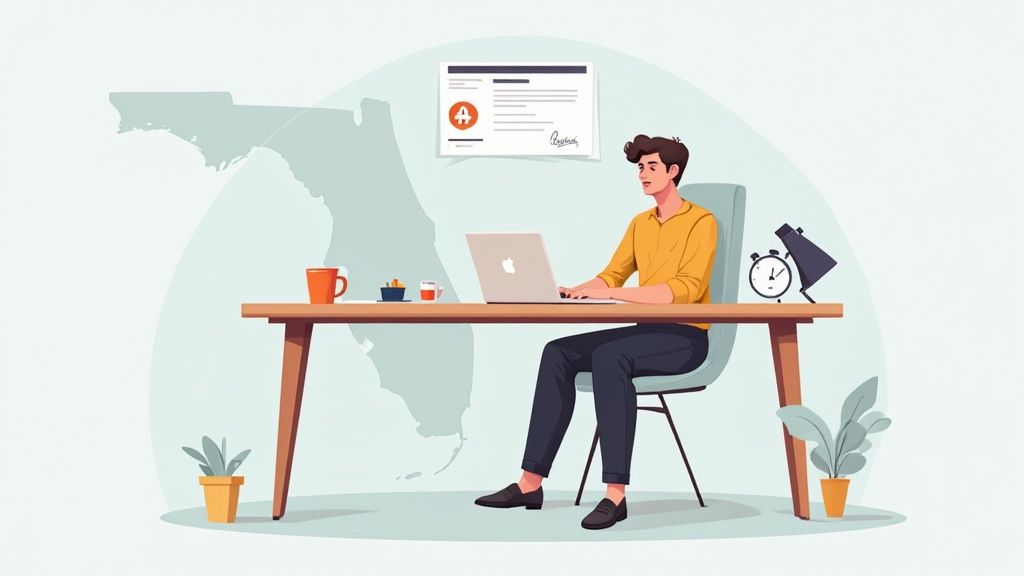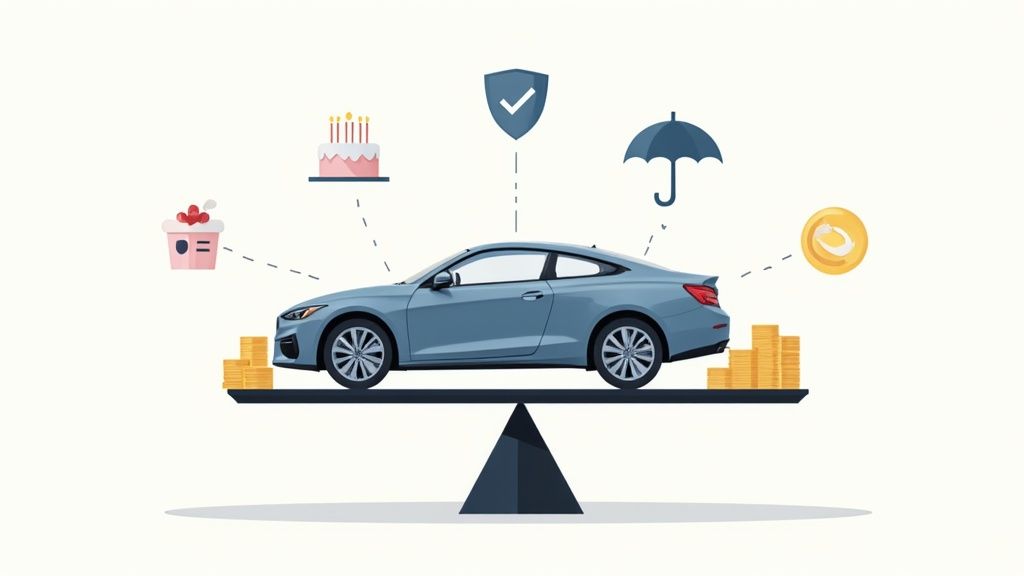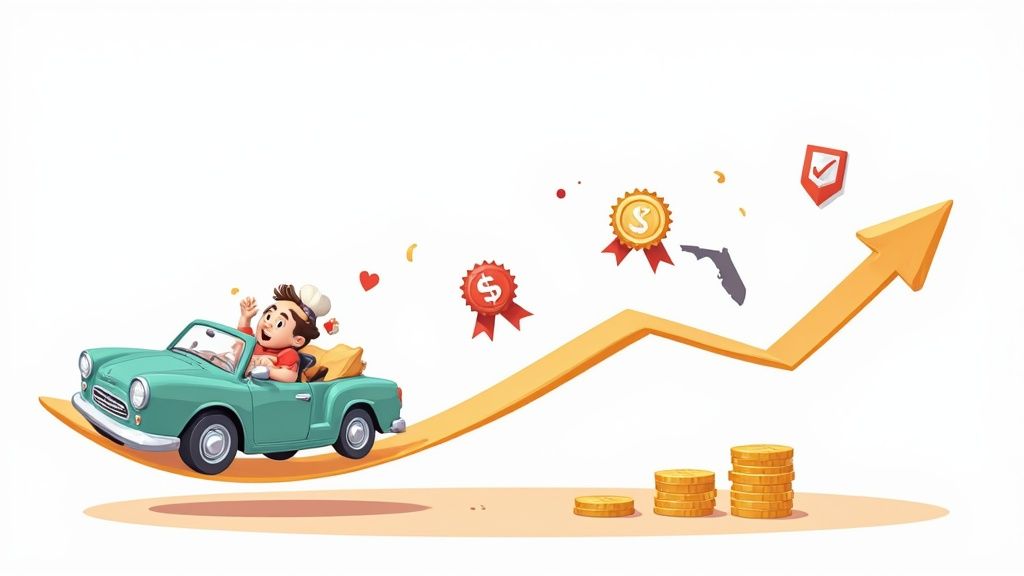When you see an aggressive driver, the best thing to do is get away from them. Your goal is not to teach them a lesson or win a fight. Instead, your goal is to get where you are going safely.
This means you should not make eye contact. You should also not use angry hand gestures or honk your horn back at them. If someone is driving too close to your bumper, just let them pass you. Staying calm and focused is how you handle aggressive drivers.
Your First Move When Facing Aggressive Drivers
It can be scary to meet someone driving with anger. However, how you react in the first few moments is very important. The main rule is simple: your safety is more important than your pride.
Reacting with anger only makes a dangerous situation worse. Consequently, it raises the risk of a traffic collision or even a violent fight. The best way to win is to make yourself an uninteresting target so the other driver moves on.
Keep your eyes on the road ahead. Make sure your doors are locked, and do your best to stay calm. If the situation gets worse and you think you are being followed, do not drive home. Your best choice is to drive to a public, well-lit place like a police station, fire department, or a busy gas station.
Immediate Safety Steps
Staying calm and acting with purpose is your best defense. Here are the most effective steps:
- Create Distance: If a car is right on your rear bumper, gently take your foot off the gas. This encourages them to drive around you. If you can, safely move into another lane. That space is your best friend.
- Avoid All Engagement: This is very important. Do not look at the other driver. Do not react to their hand signals. Also, do not honk your horn. Any response, even a small one, can be seen as a challenge and make things worse.
- Just Let Them Go: If a driver is weaving through traffic and wants to get in front of you, make it easy for them. Fighting to keep your spot can turn their impatience into road rage.
- Secure Your Vehicle: It is a simple habit, but always make sure your doors are locked and your windows are up. This creates a physical barrier and adds a layer of security.
When you are in a stressful moment, it can be hard to remember what to do. The table below shows the immediate do’s and don’ts to keep you safe.
Immediate Actions When Facing an Aggressive Driver
| Action to Take (DO) | Action to Avoid (DON’T) |
|---|---|
| Stay Calm and Focused: Keep your attention on driving safely. | Engage the Driver: Avoid eye contact, gestures, or honking. |
| Create Space: Slow down or change lanes to let them pass. | Retaliate: Don’t speed up, brake-check, or block their path. |
| Lock Your Doors: Ensure your vehicle is secure. | Drive Home if Followed: Go to a police station or public area. |
| Call for Help: If you feel threatened, dial 911 when it is safe. | Confront Them: Never get out of your car to argue or fight. |
Ultimately, your reaction decides if the situation calms down or becomes much more dangerous.

This image is a great reminder of the three main steps. First, spot the threat. Second, respond safely without fighting back. Finally, know when to report the driver to the police.
Understanding the Risks
Aggressive driving is not just annoying; it is a real danger. The statistics are serious. According to the National Highway Traffic Safety Administration (NHTSA), aggressive driving plays a part in a large number of traffic collisions each year. In 2022, for example, speeding alone was a factor in 12,151 traffic fatalities, according to NHTSA data.
These behaviors contribute to thousands of injuries and hundreds of deaths in the U.S. every year. The Governors Highway Safety Association (GHSA) also provides resources and data on dangerous driving behaviors. You can learn more from GHSA’s resources on speeding. Knowing how to handle these encounters is a defensive driving skill that could save your life.
Recognizing the Warning Signs of Road Rage

Your best defense against a road rage event is learning to see trouble before it finds you. Most of the time, a big fight does not just happen. Instead, it starts with smaller signs of anger and impatience.
When you know what to look for, you can change how you think. You can go from reacting with emotion to driving defensively. This allows you to see the situation for what it is—someone else’s bad choices—and keep yourself safe.
Common Red Flags to Watch For
Aggressive driving is not just one action. It is usually a mix of dangerous habits that create a clear pattern. Be on the lookout for drivers who are:
- Tailgating: This is a classic way to scare another driver. When someone drives too close to your bumper, they are not just being impatient. They are trying to bully you into speeding up or moving over, which leaves no room for mistakes.
- Making Angry Gestures: If you see someone shouting, waving their hands angrily, or making rude gestures, it is a clear sign they have lost their cool.
- Using Their Horn or Lights Too Much: A quick honk is one thing. But, constant honking or flashing high beams in your rearview mirror is a direct attempt to bother you.
- Changing Lanes Erratically: Drivers who weave through traffic, cut people off, and change lanes without signaling show they do not care about anyone’s safety.
It’s important to know the line between aggressive driving and road rage. Aggressive driving is a series of traffic offenses, like tailgating or weaving. Road rage, on the other hand, is a criminal offense where the driver intends to cause harm with their vehicle or another weapon.
How Frustration Spirals into Danger
It is amazing how fast a moment of frustration can get worse. Imagine a driver who is late for a meeting. First, they might start by tailgating you. When that does not work, they might start flashing their lights. If that still does not work, they could swerve around you, cutting you off and nearly causing a collision. This predictable chain of events puts everyone on the road at risk.
These behaviors have real results. As mentioned, the National Highway Traffic Safety Administration (NHTSA) data shows that speeding is a primary form of aggressive driving and a top cause of fatalities. The Insurance Institute for Highway Safety (IIHS) also tracks crash data and finds that aggressive behaviors consistently lead to deadly outcomes. You can review detailed crash statistics on the IIHS website.
Unfortunately, these events are happening more often as our roads get more crowded and stressful. To learn more, check out our guide on how to handle road rage and stop a situation from getting worse.
Proven Techniques to De-Escalate a Confrontation

So, you have spotted an aggressive driver. What you do next can make all the difference. The main goal is to show that you are not a threat and do not want to engage. As a result, this calms them down and, more importantly, keeps you safe.
The first move is not on the road—it is in your own head. Take a deep breath. It sounds simple, but that one action can stop your own “fight or flight” feelings. A calm mind makes better decisions.
Creating Physical and Mental Distance
Your number one priority is to put space between your vehicle and theirs. An aggressive driver is looking for a reaction or a fight. The best thing you can do is politely remove yourself from their world.
- Ease Off the Gas: If someone is stuck to your bumper, do not brake-check them. Just gently lift your foot off the gas pedal. This slow-down often gives them the hint to go around you without making the situation worse.
- Change Lanes: As soon as it is safe, signal and move over. Let them have the lane. This is not about “losing.” Instead, it is about winning by getting home safely.
- Use an Exit: If they keep following you, just take the next exit. You can pull over in a well-lit, public place for a moment. Or, you can just get back on the road once they are gone. It is a simple, effective way to reset the situation.
The golden rule here is to avoid engaging at all costs. Do not make eye contact or gestures. Any response, even a frustrated look, can be seen as an invitation for things to get worse.
The Power of Disengagement
Your most powerful tool is to become a boring target. By refusing to engage, you deny the aggressive driver the fight they are looking for. When they do not get a reaction, they will almost always lose interest and speed off to find another target.
Sometimes, a quick, apologetic wave can calm a small situation if you, for example, accidentally cut someone off. But you have to judge the situation. If a driver is clearly angry, it is best to do nothing at all. Your calm, steady driving sends its own message: “I’m not playing this game.”
The most important thing to remember is that their anger is not about you. It’s a reflection of their own stress or frustration. By not taking it personally, you can focus on what truly matters: your safety.
Making yourself a non-threat is the main part of de-escalation. It also helps to be aware of your own driving habits. To keep from accidentally upsetting someone, the U.S. Department of Transportation (USDOT) offers many tips on safe and responsible driving. This kind of defensive awareness can help you stay out of trouble before it even starts.
When and How to Safely Report a Dangerous Driver

There are times when another driver’s behavior crosses the line from aggressive to very dangerous. We are talking about actions that are a direct threat to everyone on the road. Knowing when to call law enforcement is not just a good idea—it can prevent a terrible event.
You should think about reporting someone for extreme actions. These include driving at very high speeds, swerving across lanes, or showing clear signs of being impaired. If you feel that you or others are in immediate danger because of how someone is driving, it is time to act.
But before you do anything, your own safety must be the top priority.
Your Safety Comes First
Let’s be very clear: never try to report a driver while your own vehicle is moving. Playing with your phone is a major distraction. Also, the last thing you want is for the aggressive driver to notice you, which could make a bad situation even worse.
The right move is to pull over to a safe, well-lit place as soon as you can. For instance, think of a busy gas station, a shopping center parking lot, or a rest stop. Once you are safely parked, then you can make the call. Your goal here is to be a good witness, not to get physically involved.
Crucial Reminder: Whatever you do, don’t follow a dangerous driver to try and get their information. Chasing them down puts you, your passengers, and everyone else on the road in unnecessary danger. Observe from a distance and let the professionals handle it.
What Information to Gather
When you call for help, the more specific you can be, the better. Clear, correct details give law enforcement the best chance of finding and stopping the dangerous driver.
Before you dial, try to gather a few key pieces of information—but only if you can do it without risking your safety. Having these details ready will make your report much more effective.
Information to Gather for Reporting a Dangerous Driver
| Information Category | Specific Details to Note |
|---|---|
| Vehicle Identification | The make, model, and color of the car. |
| License Plate | The plate number and the state it’s from. This is very helpful. |
| Driver Description | A general description of the driver, if you got a clear look. |
| Location & Direction | The road name, direction of travel, and nearest cross-street or mile marker. |
| Incident Details | A clear, short description of the dangerous behavior. |
Once you have made the report, you have done your part. Understanding the correct steps after any traffic incident is a key part of being a prepared driver. For more guidance on this, our guide on what to do after a car accident is a great resource. By reporting truly dangerous behavior, you are helping to make the roads safer for everyone.
Drive Defensively to Avoid Future Incidents
The best way to deal with an aggressive driver is to never meet them in the first place. You can make yourself a much less attractive target by simply adopting a defensive driving mindset. It is all about being proactive and focusing on your own habits. In this way, you can prevent a fight before it ever has a chance to begin.
A great place to start is by giving the car in front of you plenty of room. This is not just about avoiding a minor collision if they brake suddenly. It also signals to drivers behind you that you are not an aggressive tailgater yourself. Another simple but effective habit is using your turn signals early and often. This clears up any confusion about what you plan to do.
Manage Your Own Mindset
Let’s be honest: how you feel behind the wheel has a huge impact on how you drive. If you are stressed, angry, or running late, you are far more likely to make aggressive moves yourself. Consequently, this can easily set another driver off. It is a chain reaction you do not want to start.
So, before you even put the car in gear, take a breath. Plan your route. Just leaving five minutes earlier than you think you need to can completely change the tone of your trip. Therefore, it makes for a calmer, safer experience for you and everyone else on the road.
Your job isn’t to teach other drivers a lesson or police the highway. Your one and only goal is to get where you’re going in one piece. A true defensive mindset always puts safety first.
Key Defensive Driving Habits
Adding a few simple practices into your daily drive can make a world of difference. Think of these as the building blocks of staying safe and away from aggressive drivers.
- Treat the Left Lane as a Passing Lane: This is a big one. On highways, staying in the left lane is a major source of frustration and a sure way to get tailgated. Make your pass, and then move back to the right as soon as it is safe to do so. In Texas, for example, the state law requires drivers to move out of the left lane to let faster traffic pass, as noted on the Texas Department of Transportation (TxDOT) website.
- Be the Courteous Driver: Let someone merge in heavy traffic. Give a little wave of thanks. A small amount of patience can do wonders for keeping tensions low and traffic moving. It is a small gesture that has big benefits.
- Always Know What’s Around You: Make a habit of constantly checking your mirrors and your blind spots. Being aware of your surroundings is your best friend. In addition, it helps you spot potential trouble long before you are in the middle of it.
Creating a safer driving environment is something we all need to do. A key part of this is understanding the dangers of impaired driving. Driving under the influence of alcohol or drugs dramatically increases aggressive tendencies and crash risk. According to the Federal Highway Administration (FHWA), aggressive driving and impaired driving are a deadly combination.
By staying proactive with your own driving, you greatly lower your chances of a dangerous meeting. If you want to learn more, take a look at our complete guide on defensive driving techniques for more strategies to keep you safe.
Frequently Asked Questions About Aggressive Driving
It is a stressful situation we all hope to avoid. But knowing how to handle an aggressive driver is one of the most important parts of staying safe on the road. When things get tense, it is normal to have questions.
Let’s look at some of the most common concerns so you can feel more prepared behind the wheel.
What should I do if an aggressive driver is following me?
This is a scary situation. Your first thought might be to just get home. Do not do it. The last thing you want to do is lead an angry person to where you live.
Instead of going home, keep driving toward a safe, public, and well-lit place. Your goal is to get somewhere with lots of people and witnesses. Good options include a police station, a fire station, or a busy 24-hour store. Once you get there, stay in your car, lock the doors, and call 911. Never get out to face the other driver.
What is the difference between aggressive driving and road rage?
People often use these words to mean the same thing, but they are very different in the eyes of the law. Aggressive driving is a series of traffic offenses, like speeding, tailgating, or weaving through lanes. It is reckless and puts people at risk. Road rage, however, is a criminal offense. This is when a driver intentionally uses their vehicle to threaten or harm someone. The key difference is intent.
How can I avoid making other drivers angry in the first place?
The key is to not be the driver who causes frustration. Often, we can upset others without meaning to. Focus on being a predictable and polite driver. For example, always use your turn signals early. Check your blind spots before changing lanes. On the highway, do not stay in the left lane—it is for passing. Let people merge, especially in heavy traffic. A little courtesy goes a long way.
How much following distance should I keep from other cars?
A safe following distance is key to avoiding collisions and not appearing aggressive. The NHTSA recommends the “three-second rule.” Watch the vehicle in front of you pass a fixed object, like a sign. Then, slowly count “one-one-thousand, two-one-thousand, three-one-thousand.” If you pass the same object before you finish counting, you are too close. You should add more time in bad weather.
Are hands-free devices safer than holding my phone?
While hands-free devices are legal in many places, they are not necessarily safe. Research from the National Highway Traffic Safety Administration (NHTSA) shows that the brain remains distracted by the conversation. This is called cognitive distraction. The safest choice is to not use your phone at all while driving.
For a deeper dive into these kinds of proactive techniques, check out our driver safety course guide for more expert tips.
At BDISchool, we believe that a well-informed driver is a much safer driver. Whether you’re dealing with a recent ticket or just want to feel more confident on the road, our courses are here to help.
